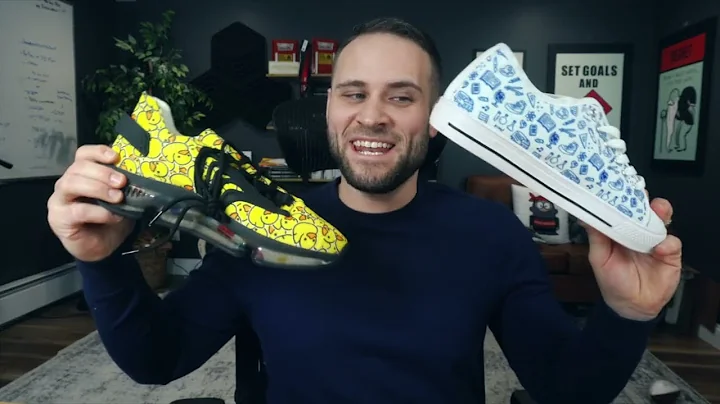Exploring the Impact of COVID-19 on Shopper Behavior
Table of Contents:
- Introduction
- The Impact of COVID-19 on Shopper Behavior
- Trends and Themes in Shopper Behavior
- Product Announcements and Projects to Support Customers
- Resources Developed by the Company
- FAQ
Introduction
Welcome to this article on the impact of COVID-19 on shopper behavior and how businesses are responding to these changes. In this article, we will explore the trends and themes that have emerged in shopper behavior, discuss the product announcements and projects implemented by businesses to better support their customers, and provide you with valuable resources developed by the company. So let's dive in and explore the evolving landscape of e-commerce and shopper behavior in these unprecedented times.
1. The Impact of COVID-19 on Shopper Behavior
The COVID-19 pandemic has brought about significant changes in shopper behavior. With the emergence of social distancing measures and the closure of physical stores, shoppers have shifted their focus to online shopping. This shift has created both challenges and opportunities for businesses. While some have struggled to meet the increased demand and shift their business models online, others have been able to capitalize on the changing trends and adapt their strategies effectively.
1.1 Changes in Customer Preferences
One notable change in shopper behavior is the shift in customer preferences for online shopping. With physical stores experiencing closures and limitations, consumers have turned to e-commerce platforms to fulfill their shopping needs. Research shows that 65% of consumers reported being unable to find everything they needed on Amazon, prompting them to seek out alternative brands and products. This presents a significant opportunity for businesses to fill the gap and capture new customers.
1.2 Shifts in Purchasing Decisions and Channels
Not only have customers changed where they buy from, but they have also changed how they make purchasing decisions. Over a third of consumers are paying more attention to marketing messages from brands, particularly through channels like email, SMS, and social media advertisements. Mobile phone usage has increased by 30%, with a 50% rise in text messaging. This presents a unique opportunity for brands to communicate and engage with their customers through these channels effectively.
1.3 Emerging Demographics in E-commerce
The COVID-19 pandemic has accelerated the adoption of e-commerce among demographics that were previously less inclined to shop online. Older demographics and customers in rural areas now make up a larger share of e-commerce purchases than ever before. A survey conducted by McKinsey shows that more than half of consumers who switched brands during the pandemic plan to maintain these new choices even after the crisis is over. This indicates a significant opportunity for brands to acquire new customers and build long-term relationships.
1.4 The Changing Landscape of Online Product Discovery
In response to the surge in online shopping, Google has made a significant change by offering all merchants the opportunity to sell on Google Shopping for free. This expansion of their product catalog aims to gain traction as the go-to destination for online product discovery. However, the increased competition on Google Shopping means that brands must find ways to stand out. Leveraging user-generated content and customer reviews can help brands differentiate themselves and increase the discoverability of their products.
2. Trends and Themes in Shopper Behavior
In this section, we will explore the trends and themes that have emerged in shopper behavior during the COVID-19 pandemic. These trends provide insights into how consumers are responding to the changing landscape and present valuable opportunities for businesses.
2.1 Increased Focus on Self-Care and Wellness
With the stresses and uncertainties brought about by the pandemic, consumers have shown an increased focus on self-care and wellness. This has led to a surge in demand for health and beauty products, particularly in categories such as skincare, haircare, and bath and body products. Brands have responded by offering virtual consultations, engaging customers through social media challenges, and providing educational content on maintaining wellness at home.
2.2 Creativity in Engaging Customers Virtually
Brands have found innovative ways to connect with customers virtually while traditional in-store experiences are limited. Virtual consultations, online classes, and live sessions with experts have allowed brands to maintain a personal and interactive relationship with their customers. Social media platforms like TikTok have also become a new marketing channel, enabling brands to engage with a wider audience through creative and entertaining content.
2.3 Flexibility in Payment Options
The uncertain economic climate has led to an increased demand for more flexible payment options. Brands have responded by partnering with buy-now-pay-later providers and offering discounts and promotions to ease the upfront financial burden on customers. By providing alternative payment methods and transparent refund and return policies, brands can instill confidence in customers and increase their willingness to make purchases.
2.4 Digitization of In-store Experiences
The pandemic has accelerated the digitization of in-store experiences, pushing brands to find innovative ways to recreate the in-store ambiance online. Brands are leveraging technology to offer virtual design services, allowing customers to visualize products in their own space. By providing personalized online consultations and creating immersive experiences through augmented reality, brands can bridge the gap between online and offline shopping.
3. Product Announcements and Projects to Support Customers
In response to the changes in shopper behavior, businesses have been implementing various product announcements and projects to better support their customers. These initiatives aim to address the evolving needs and preferences of consumers and provide a seamless shopping experience.
3.1 SMS Marketing
As consumers spend more time on their mobile phones, SMS marketing has become a powerful tool for businesses to engage with their customers. The COVID-19 pandemic has led to a 37% increase in average revenue per SMS message, indicating the effectiveness of this channel. Companies have recognized the potential of SMS marketing and have introduced tools to integrate SMS into their marketing strategies, allowing for more personalized and direct communication with customers.
3.2 Yotpo Membership Program
To help businesses bridge the gap in cash flow during these challenging times, a Yotpo membership program has been introduced. This program offers customers exclusive benefits and discounts while providing businesses with upfront cash flow. By encouraging customers to sign up for annual memberships, businesses can generate immediate revenue and build loyalty among their customer base.
3.3 Offline Solutions for Online Brands
As businesses with brick-and-mortar stores begin to reopen, offline solutions are being developed to provide customers with a seamless shopping experience across both online and offline channels. These solutions include point-of-sale systems and receipt scanning capabilities, allowing businesses to capture valuable data and provide a consistent experience to their customers.
4. Resources Developed by the Company
To support businesses and provide them with valuable resources, the company has developed various initiatives and content. These resources aim to help businesses navigate the challenges presented by the COVID-19 pandemic and capitalize on the opportunities that arise.
4.1 Partner Discounts Hub
Through collaboration with agency and tech partners, the company has compiled a list of discounted services and offers for merchants. These offers range from design and development agencies to digital marketing agencies, providing businesses with discounted access to valuable resources and services.
4.2 Your Poll Earn
Your Poll Earn is an educational series created exclusively for the company's community. This series covers a wide range of topics, including product specifics, best practices, strategies, and advice from industry experts. By signing up for Your Poll Earn, businesses can gain valuable insights and stay up to date with the latest trends.
4.3 COVID-19 Resource Station
The COVID-19 Resource Station provides a repository of resources developed by the company to assist businesses during these challenging times. From strategies and interviews to infographics and guides, businesses can find valuable information and guidance to navigate the changing landscape of e-commerce.
4.4 AMA Series
The AMA (Ask Me Anything) series, conducted through Instagram Live, allows businesses to engage in real-time discussions with brand and technology experts. This series provides an opportunity to ask questions, gain insights, and learn from industry professionals. The topics covered in the AMA sessions are determined based on the feedback and requests from the community.
FAQ
Q: What is the long-term impact of COVID-19 on shopper behavior?
A: The COVID-19 pandemic has accelerated existing trends in shopper behavior, such as the shift towards online shopping and the adoption of new channels for marketing and communication. These trends are likely to continue even after the pandemic ends, as consumers have become more accustomed to alternative shopping methods and brands have invested in creating differentiated and superior experiences.
Q: How has COVID-19 affected Amazon?
A: COVID-19 has had both positive and negative effects on Amazon. The increased demand for e-commerce has led to a surge in sales for Amazon, particularly in essential goods. However, the pandemic has also highlighted the limitations of the company's supply chain and the need for greater diversification in the marketplace. In the long term, the rise of smaller brands and the evolution of technology may impact Amazon's market share.
Q: Will customers continue with the new trends in shopper behavior?
A: Yes, the new trends in shopper behavior are likely to continue even after the pandemic ends. The shift towards online shopping, the focus on self-care and wellness, and the demand for flexible payment options have become ingrained in consumers' habits. Brands that adapt to these changes and provide unique and differentiated experiences are more likely to succeed in the long term.
Q: What concerns might shoppers have as brick-and-mortar stores reopen?
A: As brick-and-mortar stores reopen, shoppers may have concerns about their safety and the measures taken to prevent the spread of COVID-19. Brands will need to reassure customers by implementing safety protocols, such as social distancing measures and increased sanitation practices. Offering convenient and contactless shopping options, such as buy online, pick up in-store, can also help alleviate concerns.
Q: How can businesses support their customers during these challenging times?
A: Businesses can support their customers by adapting to new trends and preferences, such as offering virtual consultations, providing educational content, and ensuring flexible payment options. Building personalized relationships with customers through digital channels and providing a seamless omni-channel shopping experience can also enhance customer satisfaction and loyalty.






















